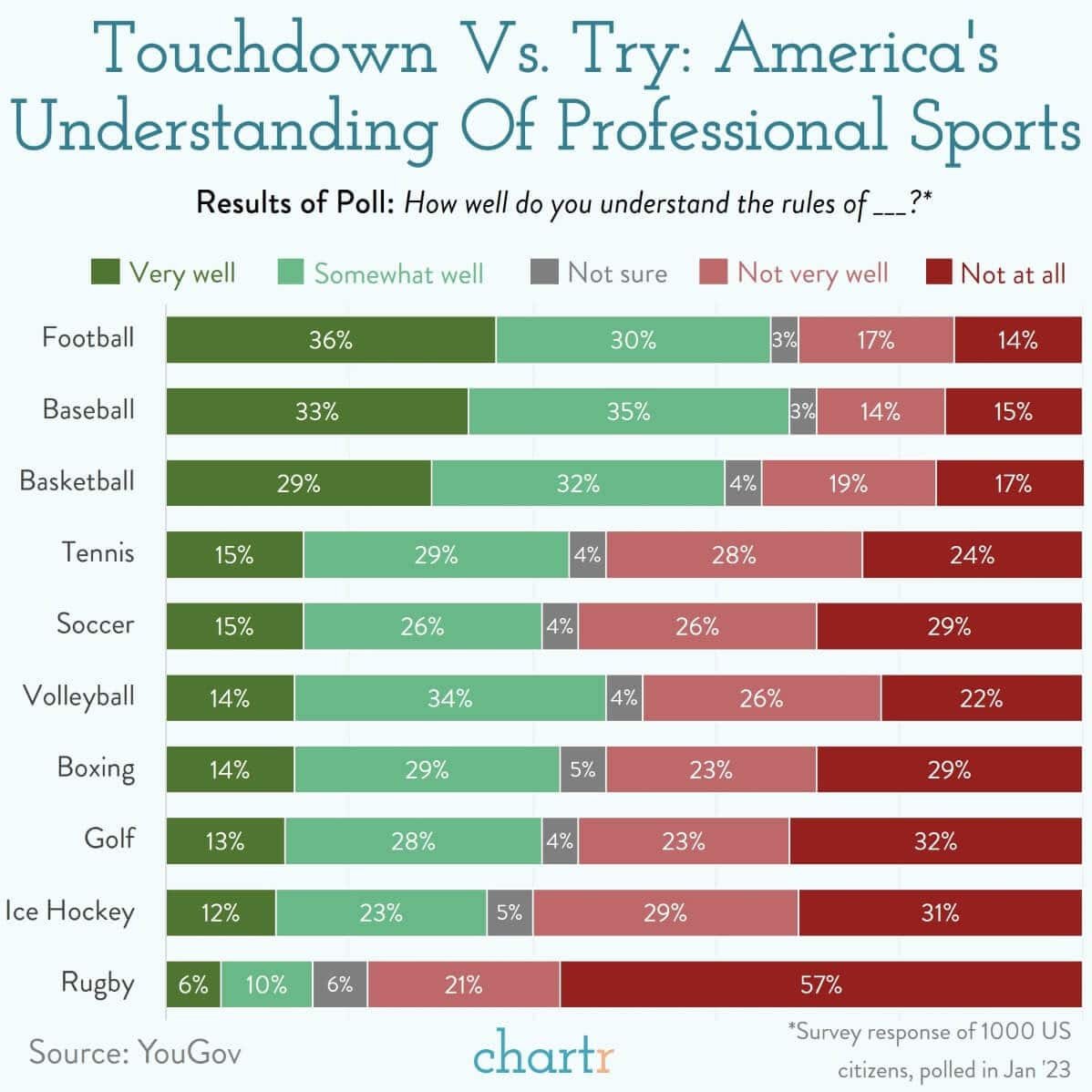What sport has the most rules? The answer might surprise you.
Sports have varying degrees of complexity. Some are straightforward, while others are intricate. In the world of sports, rules define the game. They ensure fairness, safety, and enjoyment. But which sport stands out for its sheer number of rules? This question piques curiosity among sports enthusiasts and casual fans alike.
Delving into this topic reveals fascinating insights into the structure and organization of different sports. It also highlights the dedication and commitment required to master them. So, if you’re intrigued by the intricacies of sports and the regulations that govern them, read on. Discover which sport boasts the most rules and why. The answer will give you a new appreciation for the complexity and beauty of athletic competition.

Credit: www.ussportscamps.com
Introduction To Sports Rules
Sports are an essential part of human culture. They bring people together and create a sense of community. Each sport has its own set of rules. These rules ensure fair play and safety for all participants. Some sports have simple rules. Others have complex regulations that can be hard to follow.
Importance Of Rules
Rules in sports are crucial. They ensure fairness and equality. Without rules, games would be chaotic. Athletes follow rules to compete fairly. Spectators enjoy games more when they are fair. Rules also protect players from injuries. Safety is a top priority in any sport.
Evolution Of Sports Regulations
Sports regulations have evolved over time. Early sports had few rules. With time, rules became more detailed. This made sports more organized and professional. Changes in rules often respond to new challenges. For example, technology has influenced many sports rules. Video replays help referees make better decisions. This evolution keeps sports relevant and exciting.

Credit: www.tumblr.com
Criteria For Measuring Rule Density
Determining which sport has the most rules is not straightforward. We must look at several factors. Two key criteria are the number of rules and the complexity of rules. Both aspects offer insights into the rule density of a sport.
Number Of Rules
The first criterion is the sheer number of rules a sport has. Some sports have a small rulebook. Others have extensive rules covering every possible scenario. Here is a comparison of the number of rules in different sports:
| Sport | Approximate Number of Rules |
|---|---|
| Soccer | 17 |
| Basketball | 50+ |
| Baseball | 150+ |
| American Football | 200+ |
As seen, sports like American Football and Baseball have a higher number of rules compared to Soccer.
Complexity Of Rules
The second criterion is the complexity of rules. Some rules are straightforward. Others are complex, with many conditions. Complexity can be understood by looking at:
- Length and detail of the rulebook.
- Number of exceptions and special cases.
- Interpretation by referees and officials.
For example, in American Football, rules for pass interference or holding are detailed. They have many conditions and exceptions. This makes them complex. Meanwhile, in Soccer, rules like offside are simpler.
Complex rules often need more interpretation. They can lead to debates and discussions among officials. This adds to the overall rule density of the sport.
Sports With Extensive Rulebooks
Sports with extensive rulebooks can be quite complex. Their rules cover every detail to ensure fair play and safety. These sports require players to have a deep understanding of the game. They often have dedicated referees and officials to enforce these rules. Let’s dive into two sports known for their extensive rulebooks.
Football
Football, known as soccer in some countries, has a detailed rulebook. The rules cover everything from the size of the field to player conduct. There are 17 laws in total. Each law has multiple sub-sections. These rules govern the game flow, player behavior, and even equipment standards. For example, Law 11 covers offside. It explains when a player is offside and the consequences. Referees must know all these details to make accurate calls. Players must also understand the rules to play effectively.
American Football
American football has one of the most detailed rulebooks in sports. The NFL rulebook spans over 200 pages. It covers every aspect of the game. Rules define player positions, game conduct, and scoring methods. There are specific rules for offense, defense, and special teams. Each play has guidelines to follow. For instance, the rules for a touchdown are very precise. The ball must cross the goal line while in possession. Violations can result in penalties. These can change the game’s outcome. Coaches and players study the rulebook extensively.
Detailed Analysis Of Football Rules
Football, known as soccer in some countries, is a sport with many rules. These rules ensure fair play and keep the game organized. Let’s delve into some of the key rules that make football unique.
Offside Rule
The offside rule is crucial in football. It prevents players from gaining an unfair advantage. A player is offside if they are nearer to the opponent’s goal line than both the ball and the second last opponent. This rule keeps the game fair and prevents players from goal hanging.
Fouls And Misconduct
Fouls occur when a player breaks the rules. This can include kicking, tripping, or pushing an opponent. Such actions lead to free kicks or penalties. Misconduct involves unsporting behavior. This includes arguing with the referee or violent actions. Misconduct can lead to yellow or red cards. A yellow card is a warning. A red card means the player must leave the field. These rules keep the game safe and respectful.
Exploring American Football Rules
American football is a sport known for its complex rulebook. These rules ensure fair play and safety on the field. The rules can be overwhelming, but they are crucial for the game’s integrity. Let’s dive into the essentials of American football rules.
Scoring System
In American football, there are several ways to score. Each method has its own point value:
- Touchdown: 6 points
- Extra Point: 1 point
- Two-Point Conversion: 2 points
- Field Goal: 3 points
- Safety: 2 points
The most common way to score is a touchdown. A touchdown occurs when a player carries the ball into the opponent’s end zone. After a touchdown, teams can attempt an extra point or a two-point conversion.
Penalties And Infractions
Penalties and infractions are violations of the rules. They result in yardage losses or gains. Here are some common penalties:
| Penalty | Yardage |
|---|---|
| Offside | 5 yards |
| Holding | 10 yards |
| Pass Interference | Spot of the foul |
| False Start | 5 yards |
| Personal Foul | 15 yards |
Penalties can affect the game’s outcome. For example, a holding penalty can negate a touchdown. Teams must stay disciplined to avoid costly mistakes.
Other Sports With Numerous Rules
While soccer and American football boast many rules, other sports also have complex regulations. These rules ensure fair play and maintain the sport’s integrity. Let’s explore baseball and rugby, two sports known for their numerous rules.
Baseball
Baseball has a detailed rulebook that governs every aspect of the game. From the pitcher’s mound to the strike zone, each element is defined. The rules cover batting, pitching, fielding, and base running. Umpires enforce these rules during the game. Even the equipment, like bats and gloves, must meet specific standards. The infield fly rule and the balk rule are unique to baseball. They show the sport’s complexity. These rules ensure fair competition and safety for all players.
Rugby
Rugby’s rulebook is extensive, covering both union and league formats. The laws of the game include regulations on scrums, lineouts, and rucks. Each phase of play has specific rules. Players must pass the ball backward. Tackling has safety protocols. Referees oversee the game and ensure compliance. Offside rules are crucial in rugby. They dictate player positioning and movement. Rugby’s rules are designed to promote fair play and player welfare.
Comparing Rule Complexity
When analyzing which sport has the most rules, it’s crucial to compare the complexity of these rules. This can be done by looking at different types of sports. In this section, we will compare rule complexity across various categories.
Team Sports Vs. Individual Sports
Team sports often have more rules than individual sports. This is because they need to manage the actions of multiple players. Consider soccer. It has rules for player positions, fouls, and substitutions. On the other hand, individual sports like tennis focus more on the conduct of a single player. Tennis has fewer rules, mainly about scoring and boundaries.
Basketball and American football are other team sports with many regulations. They have detailed rules about timeouts, player roles, and specific game actions. Individual sports such as track and field have simpler guidelines. These often revolve around timing and technique.
Indoor Vs. Outdoor Sports
Indoor sports like volleyball and basketball tend to have fewer environmental rules. The controlled setting of an indoor environment allows for more consistent rule application. Outdoor sports face changing weather and ground conditions. This means sports like golf and cricket have additional rules for weather and terrain.
Outdoor sports also often deal with larger playing areas. This adds complexity to rules about player movement and boundaries. In contrast, indoor sports have smaller, more standardized spaces. This reduces the number of spatial rules.
Comparing these categories helps us understand the varying complexity of rules in different sports.
Impact Of Rules On Game Play
The impact of rules on gameplay is significant in any sport. Rules can shape the way a game is played and influence strategies, game duration, and player behavior. Understanding these aspects can enhance appreciation for the sport.
Player Strategies
Rules play a critical role in shaping player strategies. In sports with many rules, players must be strategic. They need to understand and follow complex guidelines. This demands a high level of skill and awareness.
For example, in American football, there are many rules about player positions, movements, and scoring. Players must know when and how to move. They must avoid penalties to maximize their team’s performance. This can make the game both challenging and exciting.
Game Duration
Rules can also impact the game duration. In sports with many rules, games can be longer. This is because there are more stoppages for rule enforcement. These stoppages can include penalties, fouls, and reviews.
Take cricket, for instance. It has many rules about how the game is played. These rules can make matches last for several hours or even days. This extended duration can test the endurance and concentration of players.
Here is a table showing the average duration of games with complex rules:
| Sport | Average Game Duration |
|---|---|
| American Football | 3 hours |
| Cricket | Up to 5 days |
| Baseball | 3 hours |
These examples show how rules can extend the length of a game. This can make the sport more demanding and exciting for both players and fans.
)
Credit: www.giantma.com.au
Frequently Asked Questions
What Sport Has The Most Complex Rules?
American football is considered to have the most complex rules. The sport has numerous regulations governing gameplay, player conduct, and scoring. These rules ensure fair play and player safety.
Why Does American Football Have So Many Rules?
American football has many rules to ensure fair play and safety. The regulations cover various aspects of the game, making it structured and competitive.
Are There Sports With Complicated Rules?
Yes, sports like cricket, rugby, and baseball also have complicated rules. These sports involve detailed regulations that govern gameplay, scoring, and player conduct.
Which Sport Requires Extensive Rule Knowledge?
Cricket requires extensive rule knowledge due to its complex regulations. Players and fans need to understand various terms, conditions, and scoring methods.
Conclusion
Understanding which sport has the most rules can be fascinating. Each sport’s complexity adds to its charm. Some sports may seem complicated, but they offer unique experiences. Knowing the rules helps you enjoy the game more. Dive deeper into your favorite sport.
Discover its nuances and enjoy the thrill. Whether it’s football, cricket, or any other, every sport has its special appeal. Keep exploring and learning. Enjoy the journey of understanding sports.



